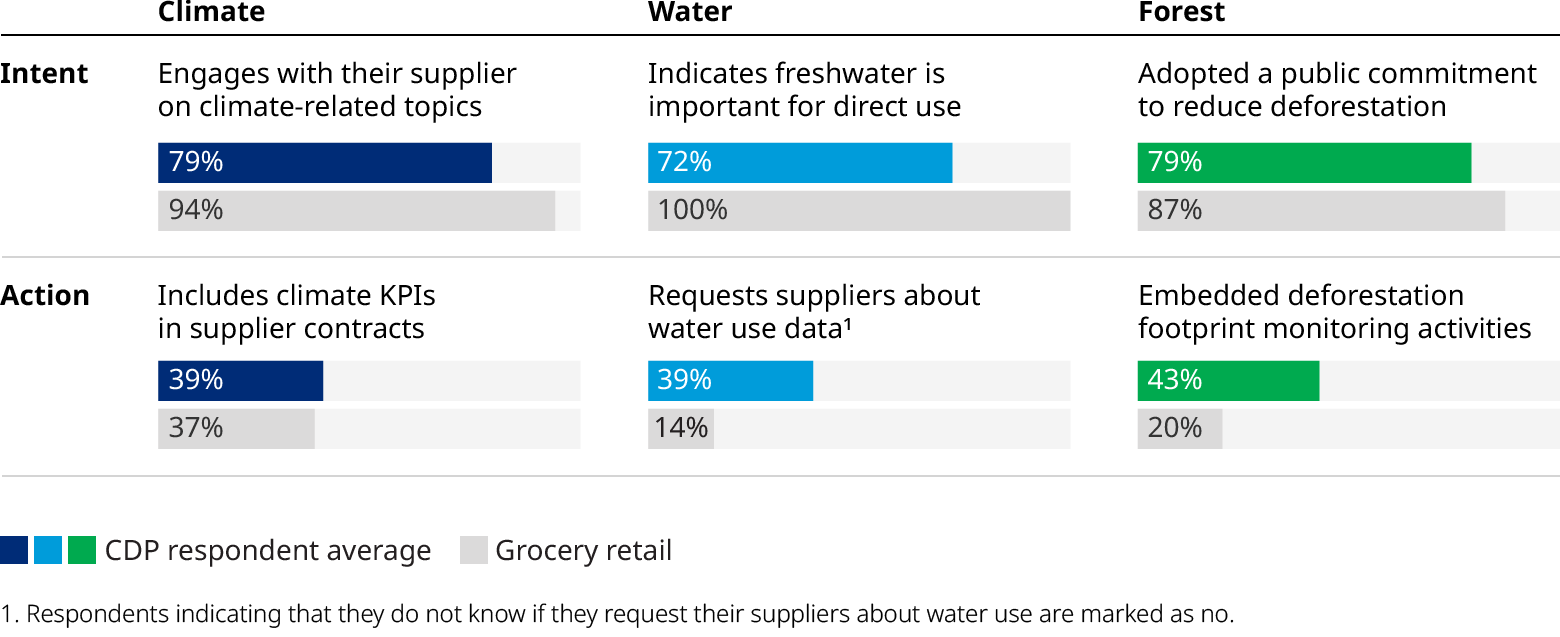Agriculture and food systems are responsible for 31% of human-caused, greenhouse gas (GHG) emissions and are also among the biggest drivers of water use, land-use change, habitat destruction, and biodiversity loss. That’s according to the latest CDP Europe report, which surveyed some 1,500 companies representing around 75% of European market capitalization on corporate efforts to cut emissions. The report is produced by global carbon monitor CDP and consulting firm Oliver Wyman.
While around half of the European companies that filled out the CDP questionnaire reported having 1.5°C climate transition plans, under 5% demonstrated advanced progress in developing ways to connect their transition plans with business plans. According to the report, the food industry has one of the widest gaps between its ambition to cut emissions and its practices.
This year’s report featured a deep dive on grocery retail, describing the sector as strong on intent, but failing to translate the desire to cut emissions into action. In this deep dive, we will highlight key conclusions of the CDP report and next steps retailers should take.

Grocery retailers are among the most value-chain dependent sectors in the economy, with 97% of their emissions produced upstream in supply chains or downstream with customers. These are referred to as Scope 3 emissions, and for companies, these emissions are among the hardest to quantify and reduce because they are not in the direct control of the manufacturer or retailer.
In practice, most grocers are not yet creating the kind of contractual relationships with suppliers that leverage doing business with them as incentive to cut emissions and protect nature. More than 70% of grocery emissions are being generated by these suppliers. Downstream, too, grocers could incentivize customers to buy products with smaller carbon footprints through pricing, assortment, and promotion practices.
The key steps grocery retailers must follow to achieve climate goals
To make meaningful steps towards closing the delivery gap, grocery retailers need to act now, detailing out how they will achieve their climate goals. For grocers the key efforts are likely to be through departments sourcing products and those merchandising them:
Develop a sustainable procurement strategy:
- Screen the assortment of products and determine how to make it more sustainable by finding new products or new sources of old products that will reduce their carbon footprints. This may require bringing new suppliers onboard with more sustainable operations or in areas that regulate impacts on nature. It also may involve relying more on private label merchandise where grocers have more control.
- Make demands on suppliers about practices deemed acceptable and set targets for reduction of emissions. Be clear about the consequences if suppliers fail to comply, which could involve cutbacks in business with the supplier or the delisting of the supplier
- Monitor the progress of suppliers through clearly structured, regular data exchanges and help the supplier, if necessary, to develop tools to measure progress
Transform merchandising and guide consumers in the right direction. Then leverage the extra efforts in negotiations to encourage suppliers to participate. For instance:
- Provide attractive placement and increase promotion for sustainable products
- Decrease promotions that encourage waste or promote unsustainable products
- Adapt target margins for sustainable products to allow for more of them to be used
Retailers should keep the following elements in mind when crafting transition plans
- Approach the transformation with both top-down and bottom-up strategies to create a culture of sustainability in which central management and operational staff are all working toward net zero
- Be transparent about the short-term financial implications as well as long-term finance and risk benefits of the transition with stakeholders including financial institutions, shareholders, employees, and even customers
- Prioritize battles and commit only to achievable and meaningful actions – avoid announcing small, token measures
- Bring consumers on board, and keep in mind that readiness strongly differs per geography
- Anticipate that this is an effort that must be sustained over decades and through successive generations of managers to be successful
As scrutiny of transition plans increases, grocery retailers will begin to feel the heat around emissions and their impact on nature. Being proactive will at least put companies on the right side of the debate.


